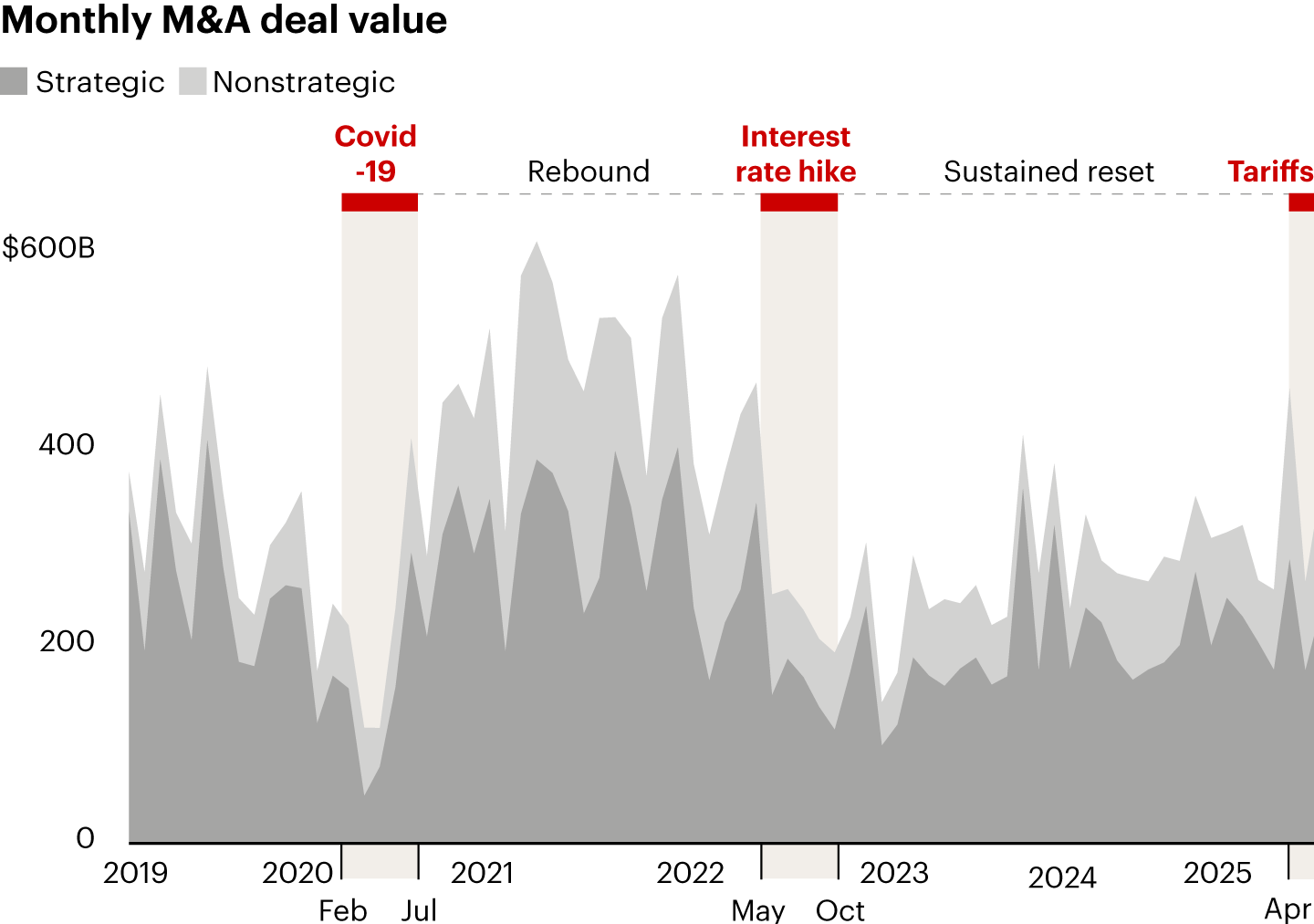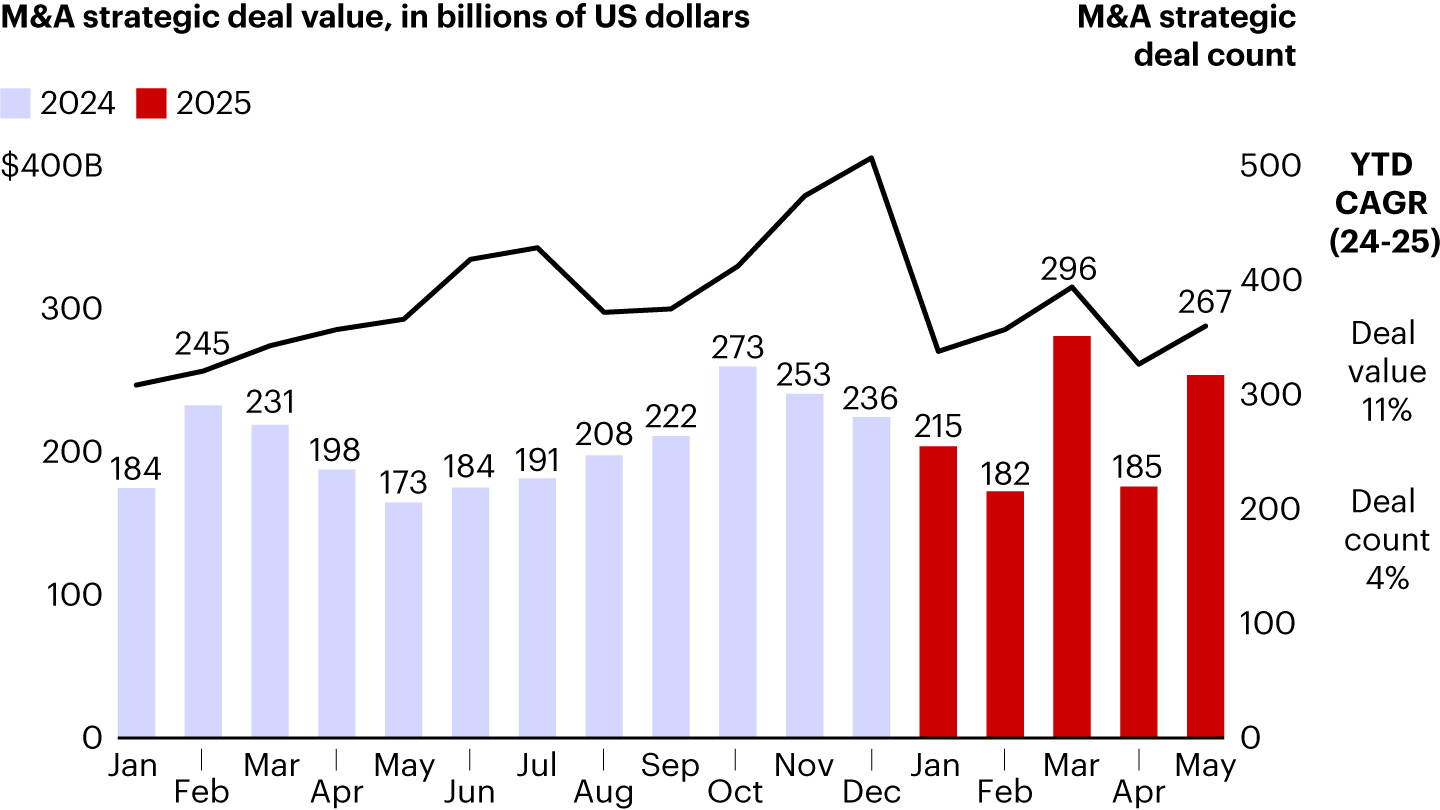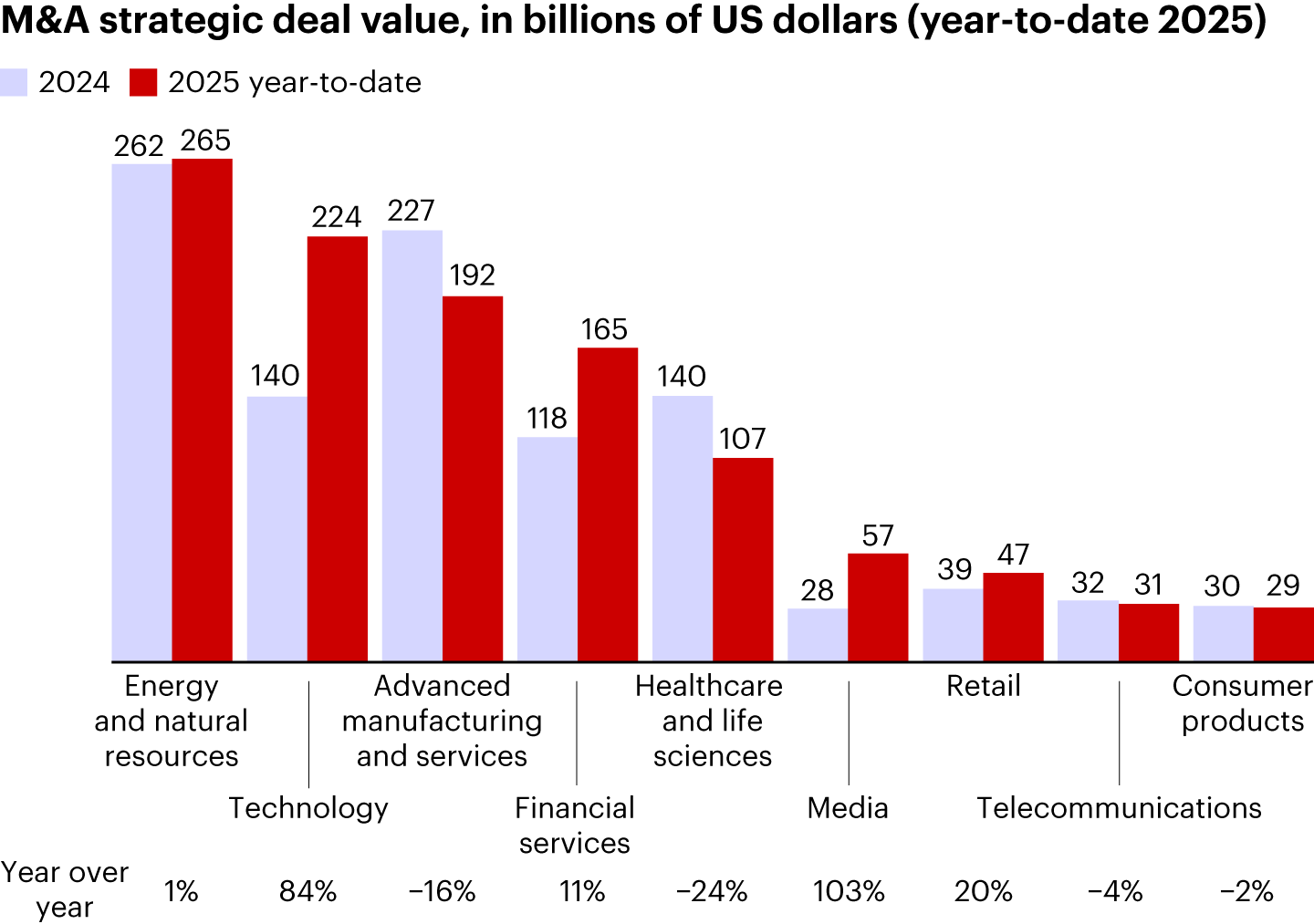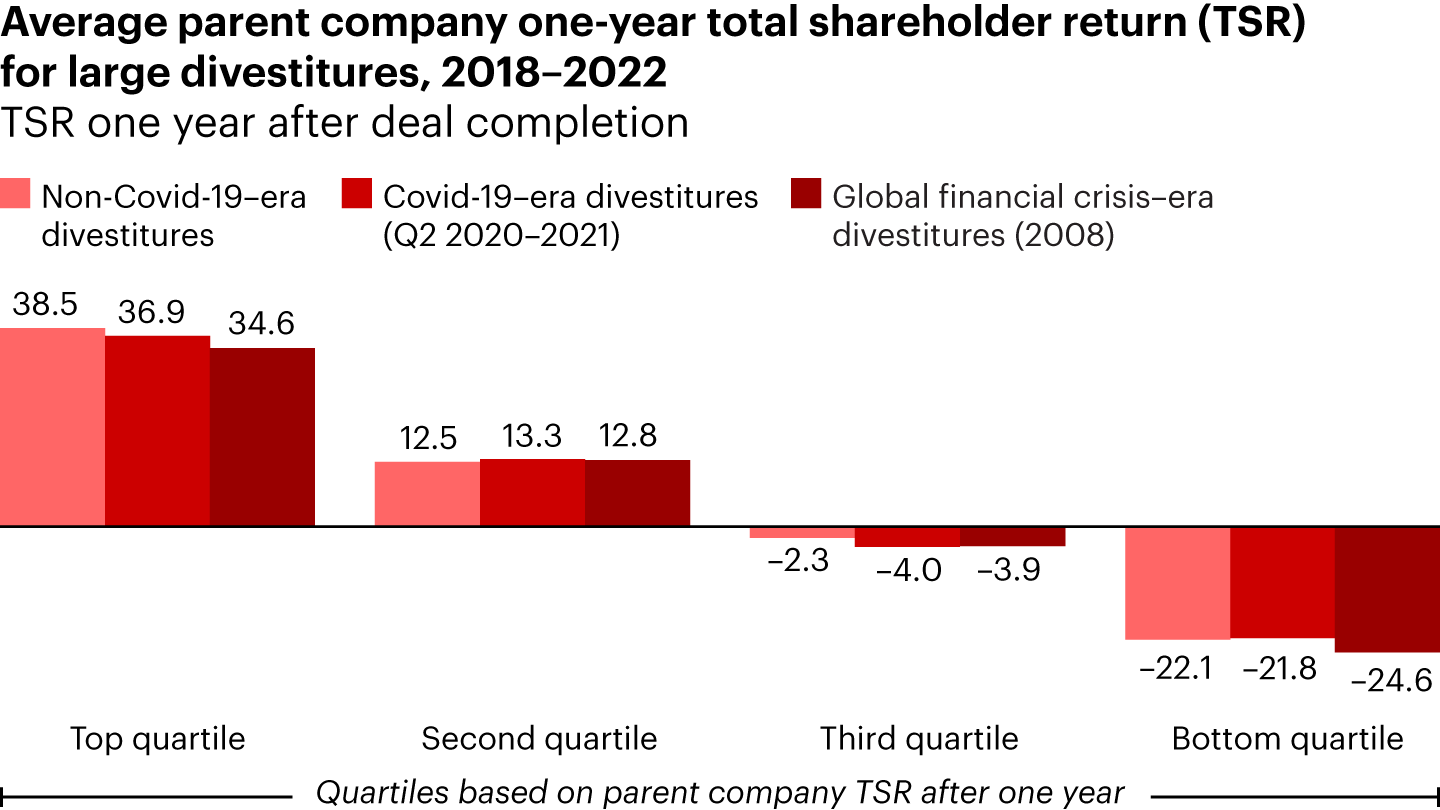レポート
 }
}
概要
- Some battle-hardened executives are drawing from past crises to make bold, strategic moves despite high interest rates, regulatory hurdles, and AI disruption.
- A new wave of deals is focused on building future-proof portfolios—through scale, capability expansion, and strategic divestitures.
- The best companies are determining how second- and third-order impacts of tariffs could alter their portfolios, M&A roadmaps, and deal pipelines.
There’s a good reason why executives feel embattled. The past five years have delivered blow after blow to their business and M&A strategy. The first big shock came when the Covid-19 pandemic jolted companies into inaction, sending 2020 M&A deal values and volumes plunging to the lowest levels in decades. The next shock occurred two years later in the form of soaring interest rates that caused executives to reassess deal economics, slowing activity almost to pandemic lows. And just when many were regaining their footing and reviving M&A plans, here come US tariffs—a third tremor with the potential to upend the confidence and clarity that underpin the market for mergers and acquisitions as bets on long-term growth and profits (see Figure 1).


注 Strategic M&A includes corporate M&A deals (which includes private equity exits) and add-ons; nonstrategic M&A includes financial investor, venture capital/corporate venture capital, and special purpose acquisition company deals
出所 DealogicBut this shock will be different. We’re already seeing evidence that some companies are not allowing tariffs (and the changed economic world order they represent) to derail M&A activity. One sign is that while deal value and volume dropped when the tariff era began in April, deal value bounced back in May. That means the impact of the US tariff announcements have been more muted than other recent shocks (see Figure 2). This could partly reflect late-stage deals announced in May. However, we feel that there’s a bigger reason and an important trend to watch: Some battle-hardened executives are learning how to live with the shocks and are becoming more strategic in using the disruption to their benefit. They have strengthened balance sheets, are running lean on cost, and building resiliency. As a result, they can respond more nimbly to strategic challenges and maintain a longer-term view on their M&A agenda.


注 Year-to-date includes January 2025 through May 2025 data; strategic M&A includes corporate M&A deals (which includes private equity exits) and add-ons; deal count includes deals valued at greater than $30 million
出所 DealogicThat’s not to suggest it’s an easy time for dealmakers. As they navigate unpredictable swings in tariff policy and financial markets, they also need to get ahead of the accelerating changes created by disruptive technologies such as generative AI. They face increasing pressure to allocate capital to these and other newly critical capabilities—possibly at the expense of investments in M&A. Interest rates are likely to remain relatively high in the US amid inflationary pressures, even as the European Central Bank continues with its steady progress of rate cuts. Meanwhile, regulatory hurdles remain high across markets. Notably, the Trump administration has sustained antitrust scrutiny, even as it brings back merger remedies and streamlined processes.
These disparate dynamics are reflected in the strategic M&A market, which has grown 11% year over year through May of 2025. The impact of tariffs is varied, depending on factors such as supply chain composition and end markets. Industrial M&A has been hit hard, with a 15% drop in value as the sector regroups, and tech has rebounded as companies across industries snap up generative AI assets (see Figure 3).


注 Year-to-date includes January 2025 through May 2025 data; strategic M&A includes corporate M&A deals (which includes private equity exits) and add-ons
出所 DealogicIn such a challenging environment, it takes unique conviction and clarity to chart a multiyear strategy and proactively pursue M&A. Yet that’s just what veteran executives are showing us they can do. They are separating the signal from the noise—and plowing ahead.
So, what lessons from recent shocks are executives applying today? Four learnings stand out.
Companies that leverage strength to continue M&A outperform those who stand still. The global financial crisis of 2008 (and its 30% decline in median valuations) led to some bold dealmaking that dramatically paid off for companies such as Kraft, with its Cadbury acquisition, and Stanley, with its purchase of Black and Decker. Similarly, the first half of 2025 showed us that some companies are pursuing opportunistic and strategically solid (or better) deals at lower valuations than this time last year. For example, Salesforce returned to AI-enabled data management company Informatica with an $8 billion offer that was about 27% lower than the amount discussed in talks last year. Tellingly, CEO Marc Benioff noted that Salesforce had been tracking Informatica for nearly 20 years. Indeed, executives that have a clear M&A roadmap grounded in multiyear strategy will be best positioned to see past near-term volatility and identify unique opportunities to make transformative moves.
Disruption creates demand for new capabilities and deals to accelerate adaptation. The Covid-19 M&A rebound, which was spurred by low interest rates and government spending, was an opportunity for some companies to pursue scope deals to accelerate digitization and gain access to critical talent. Our long-term study of M&A value creation consistently shows that frequent acquirers that do one or more deals a year outperform their less-active peers. In 2021, two-thirds of those frequent acquirers did a deal compared with 15% of infrequent acquirers.
Now, the disruption caused by generative AI mirrors the post-pandemic pursuit of game-changing capabilities. Despite higher interest rates and lower government spending, forward-looking companies across sectors are turning to M&A. In addition to Salesforce’s bid for AI data management company Informatica, consider Siemens’ nearly $5 billion deal for scientific informatics company Dotmatics or Wolters Kluwer’s purchase of Brightflag’s AI-enabled legal services for roughly $500 million to enhance its information services business.
High interest rates and cost pressures favor scale deals. When interest rates spiked in 2022, increasing the cost of capital for potential buyers, it created a swing toward scale deals that is still playing out today—and across sectors. In April, in a three-way deal, Global Payments agreed to buy Worldpay from GTCR and FIS to solidify its focus on merchant solutions while also divesting its issuer business to FIS. In energy and natural resources, Abu Dhabi National Oil Company and Austrian OMV are building a $60 billion global chemicals player called Borouge Group International by combining their Borouge and Borealis subsidiaries, respectively, and adding Nova Chemicals’ North American operations. Both transactions, although complex, focus portfolios and promise substantial scale economies: $600 million in cost synergies for Global Payments/Worldpay (plus $200 million in revenue synergies) and at least $500 million per annum in cost synergies for Borouge Group International. We expect consolidation deals will continue to define the M&A market throughout 2025, especially in high-fixed-costs industries such as financial services, energy, and telecommunications. For example, in telecommunications the Charter-Cox deal was a defensive scale play in a declining cable sector.
Winners focus on their future portfolio to expand competitive advantage. Now, the best companies are keeping a lookout for the second- and third-order impacts of tariffs and how that could alter their portfolios, M&A roadmaps, and deal pipelines. In fact, the follow-on impacts, such as a global slowdown in end-user demand, have the potential to affect companies more than tariffs do.
What are these companies doing differently? They are screening potential assets for a manufacturing footprint mapped to end markets as a way of determining tariff exposure. They are updating demand models to consider the impacts of slower global growth, supply chain realignment, and shifts in consumer behavior.
One thing these companies are not doing is letting external noise disrupt multiyear strategic transformations. They are moving forward to divest businesses that won’t serve them in a changing future. For example, in April, ABB announced its intention to spin off its robotics division to maximize its growth potential in the intelligent automation space while focusing its own portfolio on electrification and process automation. In May, Global Payments announced it would sell its payroll business to Acrisure for $1.1 billion as part of its pure-play commerce strategy. Companies such as ABB and Global Payments strategically divest companies that are no longer core or where the parenting advantage isn’t going to be the same in the future. They don’t let the low valuations inherent in a downturn dissuade them. Our research shows that divestitures that take place during downturns such as the global financial crisis and Covid-19 pandemic succeed and fail at the same rate as those that happen in more normal times (see Figure 4).


注 Non-Covid-19–era divestitures n=285; Covid-19–era divestitures n=126; Global Financial Crisis–era divestitures n=74; deals between 2018 and 2022 with deal value greater than $500 million considered; multistep deals have been consolidated into single deal; excludes deals involving partial stake divestments, increase in controlling interest and remaining interest acquisitions as well as consortium, intracompany, property portfolio deals, and acquisition of assets such as real estate
Sources: S&P Capital IQ; Dealogic; Bain M&A database, 2023For questions every CEO should ask about the 2025 M&A agenda, please see the Bain Snap Chart “M&A in a New Economic World Order.”